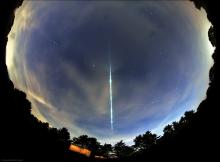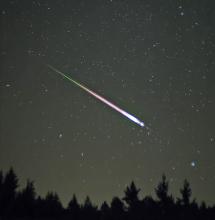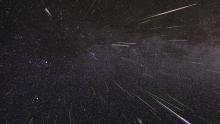Listen to today's episode of StarDate on the web the same day it airs in high-quality streaming audio without any extra ads or announcements. Choose a $8 one-month pass, or listen every day for a year for just $30.
You are here
Catching Showers
Several well-known meteor showers punctuate this month’s night skies. Most of them produce only a handful of “shooting stars” per hour, so there’s not much to see. And even the best of them generate no more than a score of meteors per hour, and only for a short time.
Astronomers have also compiled a list of possible meteor showers — more than 300 spread throughout the year. And they’re using networks of automated cameras and telescopes to try to confirm them. The observations will help the astronomers identify the objects that cause the showers.
A meteor shower occurs when Earth flies through the orbital path of a comet or asteroid, which sheds bits of debris as it orbits the Sun. These particles ram into the atmosphere at tens of thousands of miles per hour, forming the streaks of light known as meteors.
A California-based network known as CAMS has hundreds of cameras in the United States, western Europe, Africa, and elsewhere. If two or more cameras spot the same meteor, scientists can triangulate the observations to trace where the meteor came from. Meteors that come from the same direction in space, at the same time of year and at the same speed, probably came from a single object, so they form a meteor shower.
These observations can help scientists forecast future meteor showers. Among other things, that could help protect orbiting spacecraft from damage by tiny space rocks.
We’ll talk about a bigger space rock tomorrow.
Script by Damond Benningfield






